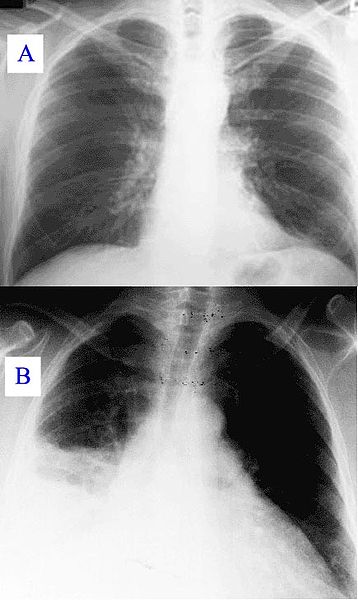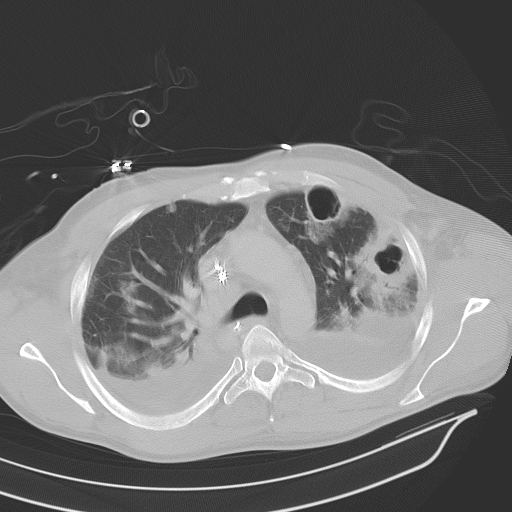[1]
Lowy FD. Staphylococcus aureus infections. The New England journal of medicine. 1998 Aug 20:339(8):520-32
[PubMed PMID: 9709046]
[2]
Francis JS, Doherty MC, Lopatin U, Johnston CP, Sinha G, Ross T, Cai M, Hansel NN, Perl T, Ticehurst JR, Carroll K, Thomas DL, Nuermberger E, Bartlett JG. Severe community-onset pneumonia in healthy adults caused by methicillin-resistant Staphylococcus aureus carrying the Panton-Valentine leukocidin genes. Clinical infectious diseases : an official publication of the Infectious Diseases Society of America. 2005 Jan 1:40(1):100-7
[PubMed PMID: 15614698]
[3]
Hind CR. Pulmonary complications of intravenous drug misuse. 1. Epidemiology and non-infective complications. Thorax. 1990 Nov:45(11):891-8
[PubMed PMID: 2256022]
[4]
Aliberti S, Reyes LF, Faverio P, Sotgiu G, Dore S, Rodriguez AH, Soni NJ, Restrepo MI, GLIMP investigators. Global initiative for meticillin-resistant Staphylococcus aureus pneumonia (GLIMP): an international, observational cohort study. The Lancet. Infectious diseases. 2016 Dec:16(12):1364-1376. doi: 10.1016/S1473-3099(16)30267-5. Epub 2016 Sep 1
[PubMed PMID: 27593581]
[5]
Self WH, Wunderink RG, Williams DJ, Zhu Y, Anderson EJ, Balk RA, Fakhran SS, Chappell JD, Casimir G, Courtney DM, Trabue C, Waterer GW, Bramley A, Magill S, Jain S, Edwards KM, Grijalva CG. Staphylococcus aureus Community-acquired Pneumonia: Prevalence, Clinical Characteristics, and Outcomes. Clinical infectious diseases : an official publication of the Infectious Diseases Society of America. 2016 Aug 1:63(3):300-9. doi: 10.1093/cid/ciw300. Epub 2016 May 8
[PubMed PMID: 27161775]
[6]
Strieter RM, Belperio JA, Keane MP. Host innate defenses in the lung: the role of cytokines. Current opinion in infectious diseases. 2003 Jun:16(3):193-8
[PubMed PMID: 12821807]
Level 3 (low-level) evidence
[7]
Metlay JP, Kapoor WN, Fine MJ. Does this patient have community-acquired pneumonia? Diagnosing pneumonia by history and physical examination. JAMA. 1997 Nov 5:278(17):1440-5
[PubMed PMID: 9356004]
[8]
Mandell LA, Wunderink RG, Anzueto A, Bartlett JG, Campbell GD, Dean NC, Dowell SF, File TM Jr, Musher DM, Niederman MS, Torres A, Whitney CG, Infectious Diseases Society of America, American Thoracic Society. Infectious Diseases Society of America/American Thoracic Society consensus guidelines on the management of community-acquired pneumonia in adults. Clinical infectious diseases : an official publication of the Infectious Diseases Society of America. 2007 Mar 1:44 Suppl 2(Suppl 2):S27-72
[PubMed PMID: 17278083]
Level 3 (low-level) evidence
[9]
Syrjälä H, Broas M, Suramo I, Ojala A, Lähde S. High-resolution computed tomography for the diagnosis of community-acquired pneumonia. Clinical infectious diseases : an official publication of the Infectious Diseases Society of America. 1998 Aug:27(2):358-63
[PubMed PMID: 9709887]
[10]
van der Eerden MM, Vlaspolder F, de Graaff CS, Groot T, Jansen HM, Boersma WG. Value of intensive diagnostic microbiological investigation in low- and high-risk patients with community-acquired pneumonia. European journal of clinical microbiology & infectious diseases : official publication of the European Society of Clinical Microbiology. 2005 Apr:24(4):241-9
[PubMed PMID: 15902529]
[11]
Christ-Crain M, Jaccard-Stolz D, Bingisser R, Gencay MM, Huber PR, Tamm M, Müller B. Effect of procalcitonin-guided treatment on antibiotic use and outcome in lower respiratory tract infections: cluster-randomised, single-blinded intervention trial. Lancet (London, England). 2004 Feb 21:363(9409):600-7
[PubMed PMID: 14987884]
Level 1 (high-level) evidence
[12]
Jiang H, Tang RN, Wang J. Linezolid versus vancomycin or teicoplanin for nosocomial pneumonia: meta-analysis of randomised controlled trials. European journal of clinical microbiology & infectious diseases : official publication of the European Society of Clinical Microbiology. 2013 Sep:32(9):1121-8. doi: 10.1007/s10096-013-1867-z. Epub 2013 Apr 10
[PubMed PMID: 23568605]
Level 1 (high-level) evidence
[13]
Wang Y, Zou Y, Xie J, Wang T, Zheng X, He H, Dong W, Xing J, Dong Y. Linezolid versus vancomycin for the treatment of suspected methicillin-resistant Staphylococcus aureus nosocomial pneumonia: a systematic review employing meta-analysis. European journal of clinical pharmacology. 2015 Jan:71(1):107-15. doi: 10.1007/s00228-014-1775-x. Epub 2014 Oct 30
[PubMed PMID: 25355172]
Level 1 (high-level) evidence
[14]
Liu C, Bayer A, Cosgrove SE, Daum RS, Fridkin SK, Gorwitz RJ, Kaplan SL, Karchmer AW, Levine DP, Murray BE, J Rybak M, Talan DA, Chambers HF, Infectious Diseases Society of America. Clinical practice guidelines by the infectious diseases society of america for the treatment of methicillin-resistant Staphylococcus aureus infections in adults and children. Clinical infectious diseases : an official publication of the Infectious Diseases Society of America. 2011 Feb 1:52(3):e18-55. doi: 10.1093/cid/ciq146. Epub 2011 Jan 4
[PubMed PMID: 21208910]
Level 1 (high-level) evidence
[15]
Kalil AC, Metersky ML, Klompas M, Muscedere J, Sweeney DA, Palmer LB, Napolitano LM, O'Grady NP, Bartlett JG, Carratalà J, El Solh AA, Ewig S, Fey PD, File TM Jr, Restrepo MI, Roberts JA, Waterer GW, Cruse P, Knight SL, Brozek JL. Management of Adults With Hospital-acquired and Ventilator-associated Pneumonia: 2016 Clinical Practice Guidelines by the Infectious Diseases Society of America and the American Thoracic Society. Clinical infectious diseases : an official publication of the Infectious Diseases Society of America. 2016 Sep 1:63(5):e61-e111. doi: 10.1093/cid/ciw353. Epub 2016 Jul 14
[PubMed PMID: 27418577]
Level 1 (high-level) evidence
[16]
Gillet Y, Issartel B, Vanhems P, Fournet JC, Lina G, Bes M, Vandenesch F, Piémont Y, Brousse N, Floret D, Etienne J. Association between Staphylococcus aureus strains carrying gene for Panton-Valentine leukocidin and highly lethal necrotising pneumonia in young immunocompetent patients. Lancet (London, England). 2002 Mar 2:359(9308):753-9
[PubMed PMID: 11888586]


